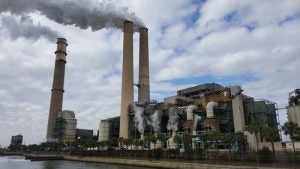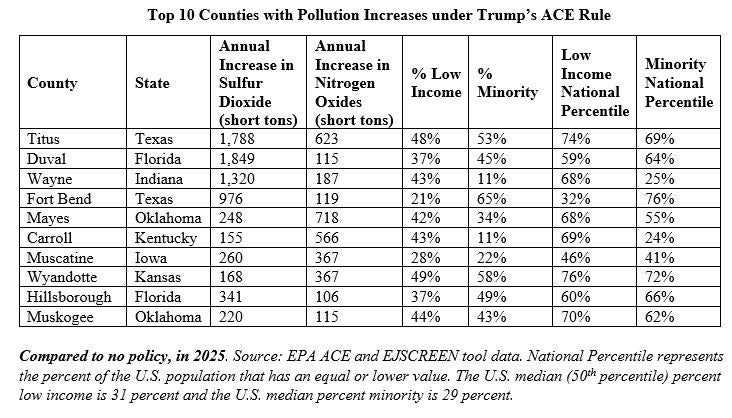Co-authored by Laura Supple and Rama Zakaria
The Trump administration is expected to soon finalize a rule that will throw out the Clean Power Plan – the first and only nation-wide limit on carbon pollution from existing power plants – and replace it with a “do-nothing” rule. Unlike the common-sense, market-based approach of the Clean Power Plan, the final rule is expected to mirror Wheeler’s proposed replacement–which contains no binding limits on carbon pollution, leaving it to the states to establish standards based on only a narrow and ineffective menu of operational efficiency tweaks for coal-fired power plants.

EPA’s own analysis has shown that this proposed replacement would increase climate pollution and dangerous soot and smog pollution, causing thousands of additional deaths and childhood asthma attacks every year compared to the Clean Power Plan, and may even increase pollution in several states compared to having no policy at all. In addition to disregarding the health and wellbeing of Americans, the proposed rule represents a tragic lost opportunity to achieve the deep, cost-effective reductions in pollution that are needed to address the urgent threat of climate change – and move the U.S. forward into a clean energy economy.
Here are four reasons why:
Power companies are making bold commitments to cut pollution, investing in cleaner technologies that deliver high-quality power at low cost to consumers
Power companies are setting ambitious goals to reduce pollution and increase the share of renewable technologies in their energy mix. Some of the largest power providers in the country have recognized the long-term economic value of renewable power and cleaner energy, setting their own targets to reduce pollution well below what the Clean Power Plan requires.
Xcel Energy, a utility serving 3.6 million customers across 8 Midwestern states, has already reduced carbon pollution by about 38% below 2005 levels while keeping costs low for its consumers. According to Xcel, its residential customer electric bill has decreased 3% in the past five years and is on average $28 lower per month than the national average. Xcel also recently ramped up its own ambitions, committing to cut carbon pollution 80% below 2005 levels by 2030, and achieve 100% clean power by 2050.
Other companies are also joining the trend towards decarbonizing their electricity mix, including Idaho Power, which has committed to 100% carbon-free electricity by 2045, and Platte River Power Authority, which aims to provide 100% renewable energy by 2030.
States and cities across the country are also setting bold targets to reduce pollution and expand the use of renewable energy. Seven states, 11 counties, and 125 U.S. cities have committed to 100% renewable energy, and at least 27 states have long-term policies establishing quantitative energy savings targets. These initiatives are making energy supplies more robust, reliable, and affordable, demonstrating that ambitious pollution reduction strategies can be good for the environment, good for business, and good for consumers.
Power sector trends have made deeper reductions achievable and cost-effective
Thanks in part to the ongoing market shift towards a cleaner electricity resource mix, the power sector is decarbonizing faster than was predicted just a few years ago.
In 2015, when the Clean Power Plan was finalized, the Energy Information Administration (EIA) projected baseline power sector carbon dioxide pollution would drop 10% from 2005 levels by 2030. Based on recent trends and technological developments, however, EIA’s most recent projections estimate that power sector carbon pollution would be at 34% below 2005 levels by 2030 – surpassing Clean Power Plan targets – even without federal climate regulation.
To be clear, we need the long-term regulatory signal established by meaningful federal regulation to ensure these trends continue and secure pollution reductions. Now more than ever, it is imperative that EPA use this momentum to set even greater climate protection targets in order to achieve the rapid reductions in carbon pollution that scientists say are necessary to avoid the worst impacts of climate change.
Plummeting costs of clean energy technologies are making pollution reduction more affordable and economical than ever
Targets for the Clean Power Plan relied on the National Renewable Energy Laboratory’s (NREL) 2015 Annual Technology Baseline projections of renewable energy costs. In its latest 2018 report, NREL predicted that the costs of onshore wind in 2030 would be 28% lower than 2015 projections, and utility-scale solar PV costs could be up to 68% lower.
These projections match trends we see on the ground. Recent filings from Xcel Energy to the Colorado Public Utilities Commission include proposals for wind power between $11 to $18/MWh – cheaper than the operating cost of all existing coal plants in Colorado – and solar-plus-storage bids not much higher than standalone solar. Last year, NV Energy reported even lower bids, setting record-low prices in its solar and solar-plus-storage request for proposals.
Overall, electricity from renewables is already cheaper than electricity from fossil fuels in many parts of the country. PacifiCorp, a majority-coal power provider, recently found it could save money by retiring 60% of its coal fleet by 2022 and replacing those units with renewables. In a 2019 analysis, Energy Innovation reported that the U.S. has officially entered the “coal cost crossover,” finding that local (within 35 miles) wind and solar generation could replace 74% of U.S. coal plants at an immediate cost savings to customers. By 2025, 86% of coal power plants could be replaced with local renewable generation.
Recent modeling shows far more ambitious and cost-effective pollution reductions can be achieved
Several studies demonstrate just how ambitious climate targets could be – with the right set of regulatory and market-based strategies. A range of analyses show that far greater reductions in carbon pollution can be achieved at low cost.
In 2015, EPA estimated the cost of achieving the Clean Power Plan targets to be in the range of $24 to $37 per ton of carbon over the 2022 to 2030 compliance period. Recent updated analysis using the same power sector model, however, found that much more ambitious carbon pollution reductions of more than 50% below 2005 levels are possible at similar costs to the Clean Power Plan.
EIA also found that even greater reductions of 68% below 2005 levels could be achieved by 2030 at modest cost. A 2016 study by the Union of Concerned Scientists showed that in a “Mid-Cost Case”, power sector carbon pollution limits of 76% below 2005 levels by 2030 could be cost-effectively achieved. Modeling by Columbia University Center and Rhodium Group also suggest that similar strategies could cut power sector carbon pollution by 72 to 76% below 2005 levels by 2030.
At a time when the threats of climate change have never been more apparent, EPA must move forward on climate action with emission reduction targets that surpass the ambition of the Clean Power Plan and protect human health and the environment from dangerous pollution. Instead, Wheeler’s proposed replacement misses a tremendous opportunity to secure deep reductions in carbon pollution and propel the U.S. into a clean energy future.
 This coming Monday, the Supreme Court will consider hundreds of petitions for review, which ask the Court to take up cases for full consideration during its new term. Among the petitions for review are four from coal companies and states asking the Court to review the D.C. Circuit decision overturning the Trump administration’s rule weakening regulations of carbon pollution from power plants. For multiple reasons the four petitions lack merit.
This coming Monday, the Supreme Court will consider hundreds of petitions for review, which ask the Court to take up cases for full consideration during its new term. Among the petitions for review are four from coal companies and states asking the Court to review the D.C. Circuit decision overturning the Trump administration’s rule weakening regulations of carbon pollution from power plants. For multiple reasons the four petitions lack merit.











 (This post was co-written by EDF intern Laura Supple)
(This post was co-written by EDF intern Laura Supple)